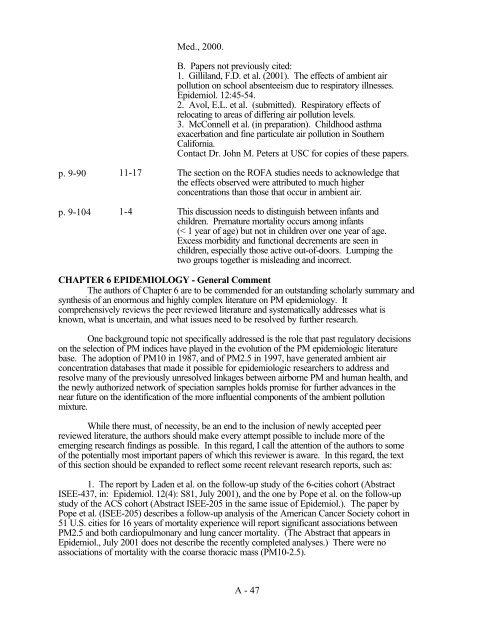Review of the Air Quality Criteria Document for Particulate Matter
Review of the Air Quality Criteria Document for Particulate Matter
Review of the Air Quality Criteria Document for Particulate Matter
- No tags were found...
Create successful ePaper yourself
Turn your PDF publications into a flip-book with our unique Google optimized e-Paper software.
Med., 2000.B. Papers not previously cited:1. Gilliland, F.D. et al. (2001). The effects <strong>of</strong> ambient airpollution on school absenteeism due to respiratory illnesses.Epidemiol. 12:45-54.2. Avol, E.L. et al. (submitted). Respiratory effects <strong>of</strong>relocating to areas <strong>of</strong> differing air pollution levels.3. McConnell et al. (in preparation). Childhood asthmaexacerbation and fine particulate air pollution in Sou<strong>the</strong>rnCali<strong>for</strong>nia.Contact Dr. John M. Peters at USC <strong>for</strong> copies <strong>of</strong> <strong>the</strong>se papers.p. 9-90 11-17 The section on <strong>the</strong> ROFA studies needs to acknowledge that<strong>the</strong> effects observed were attributed to much higherconcentrations than those that occur in ambient air.p. 9-104 1-4 This discussion needs to distinguish between infants andchildren. Premature mortality occurs among infants(< 1 year <strong>of</strong> age) but not in children over one year <strong>of</strong> age.Excess morbidity and functional decrements are seen inchildren, especially those active out-<strong>of</strong>-doors. Lumping <strong>the</strong>two groups toge<strong>the</strong>r is misleading and incorrect.CHAPTER 6 EPIDEMIOLOGY - General CommentThe authors <strong>of</strong> Chapter 6 are to be commended <strong>for</strong> an outstanding scholarly summary andsyn<strong>the</strong>sis <strong>of</strong> an enormous and highly complex literature on PM epidemiology. Itcomprehensively reviews <strong>the</strong> peer reviewed literature and systematically addresses what isknown, what is uncertain, and what issues need to be resolved by fur<strong>the</strong>r research.One background topic not specifically addressed is <strong>the</strong> role that past regulatory decisionson <strong>the</strong> selection <strong>of</strong> PM indices have played in <strong>the</strong> evolution <strong>of</strong> <strong>the</strong> PM epidemiologic literaturebase. The adoption <strong>of</strong> PM10 in 1987, and <strong>of</strong> PM2.5 in 1997, have generated ambient airconcentration databases that made it possible <strong>for</strong> epidemiologic researchers to address andresolve many <strong>of</strong> <strong>the</strong> previously unresolved linkages between airborne PM and human health, and<strong>the</strong> newly authorized network <strong>of</strong> speciation samples holds promise <strong>for</strong> fur<strong>the</strong>r advances in <strong>the</strong>near future on <strong>the</strong> identification <strong>of</strong> <strong>the</strong> more influential components <strong>of</strong> <strong>the</strong> ambient pollutionmixture.While <strong>the</strong>re must, <strong>of</strong> necessity, be an end to <strong>the</strong> inclusion <strong>of</strong> newly accepted peerreviewed literature, <strong>the</strong> authors should make every attempt possible to include more <strong>of</strong> <strong>the</strong>emerging research findings as possible. In this regard, I call <strong>the</strong> attention <strong>of</strong> <strong>the</strong> authors to some<strong>of</strong> <strong>the</strong> potentially most important papers <strong>of</strong> which this reviewer is aware. In this regard, <strong>the</strong> text<strong>of</strong> this section should be expanded to reflect some recent relevant research reports, such as:1. The report by Laden et al. on <strong>the</strong> follow-up study <strong>of</strong> <strong>the</strong> 6-cities cohort (AbstractISEE-437, in: Epidemiol. 12(4): S81, July 2001), and <strong>the</strong> one by Pope et al. on <strong>the</strong> follow-upstudy <strong>of</strong> <strong>the</strong> ACS cohort (Abstract ISEE-205 in <strong>the</strong> same issue <strong>of</strong> Epidemiol.). The paper byPope et al. (ISEE-205) describes a follow-up analysis <strong>of</strong> <strong>the</strong> American Cancer Society cohort in51 U.S. cities <strong>for</strong> 16 years <strong>of</strong> mortality experience will report significant associations betweenPM2.5 and both cardiopulmonary and lung cancer mortality. (The Abstract that appears inEpidemiol., July 2001 does not describe <strong>the</strong> recently completed analyses.) There were noassociations <strong>of</strong> mortality with <strong>the</strong> coarse thoracic mass (PM10-2.5).A - 47
















